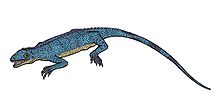
Common Milleretid Morphology.
The millerettids are an extinct group of Upper Permian South African anapsids parereptiles. They were small insectivores and probably resembled modern lizards in appearance and lifestyle.
Species
Millerosaurus pricei

Millerosaurus pricei.
Millerosaurus pricei is an extinct species of permian small parareptile from South Africa, dated to the Permian age. Unlike many other Anapsidan reptiles, it had holes (Fenestrae) behind the eyesockets in the skull. It had a slabsided body, long tail, and a narrow but triangular skull (about 2 inch long) with large eyes. Likely It had a lifestyle similar to the modern lizards, and scientists believe it was an insectivore. The other species are: Millerosaurus ornatus, and Millerosaurus nuffieldi.
Broomia perplexa and Milleropsis pricei

Milleropsis pricei skeleton.
Broomia perplexa and Milleropsis pricei are millerettid anapsid permian parareptiles from South Africa.
- Broomia perplexa was classified as a millerettid by J. C. Cisneros in 2008.
- Milleropsis pricei was assigned to Millerettidae by C. E. Gow in 1972.
Milleretta rubidgei

Milleretta rubidgei.
Milleretta rubidgei was a Late Permian fast-moving parareptile from South Africa, 250 million years ago. Fossils have been found at the Oberperm site. Milleretta rubidgei was a moderately sized, lizard-like animal, about 60 centimetres (24 in) in length. It was probably insectivorous and had acute hearing. Although once thought to have been ancestral to the diapsids, the group that includes lizards, the discovery of much older diapsid fossils has since ruled this possibility out. This is only one representative species of its genus.
Eunotosaurus africanus

Eunotosaurus africanus.
Eunotosaurus africanus is a species of Middle Permian parareptile from the Karoo Supergroup of South Africa. It was once widely accepted as the missing link between turtles and their prehistoric ancestors. Many fossils have been found showing a semi-rigid, turtle-like rib cage, one which presumably necessitated a tortoise-like fashion of walking. The ribs are very wide and flat, touching each other to form broad plates analogous to the carapace of a turtle. Moreover, the number of vertebrae, the size of the vertebrae, and their structure are nearly identical to those of some turtles. Despite the many similarities to turtles, Eunotosaurus has a skull that shares many characteristics with the skulls of more primitive anapsids. Because of these features, Eunotosaurus africanus is now placed within the Parareptilia and is not widely considered an immediate ancestor of turtles. According to this view, the expanded ribs and similar vertebral column are a case of evolutionary convergence.
History
Eunotosaurus africanus was named in 1892, but it was not until 1914 that it was proposed to be an ancestor of Chelonia, the turtle order. English zoologist D. M. S. Watson claimed that Eunotosaurus was transitional between cotylosaurs (now referred to as captorhinids) and Chelonia. He compared it to "Archichelone", a name he devised for a hypothetical chelonian ancestor, noting that its ribs appeared to be intermediate between those of turtles and other tetrapods. Watson's "Archichelone" had a pelvic girdle that was pushed back on the vertebral column and placed under the shell. However, fossils of Eunotosaurus show that the pelvis is in the normal tetrapod position and is placed over the ribs rater than within them, as in modern turtles. Eunotosaurus was considered the ancestor of turtles up until the late 1940s. In his 1956 book Osteology of the Reptiles, American paleontologist Alfred Sherwood Romer claimed that Eunotosaurus could not be included within Chelonia based on the available evidence. He placed it within Anapsida in its own order incertae sedis. Over a century after its naming, Eunotosaurus was known from less than a dozen specimens, with very little material known from the skull. Despite the paucity of material, it was well described. Two additional skeletons were unearthed from the Karoo Supergroup and described in 1999. They are now housed in the Bernard Price Institute for Palaeontological Research in Johannesburg and the National Museum, Bloemfontein. While relatively rare, Eunotosaurus is common enough in the Karoo to be used as a biostratigraphic marker. It is present in the upper Tapinocephalus Assemblage Zone and in all parts of the succeeding Pristerognathus Assemblage Zone.
Classification
Eunotosaurus was assigned to its own family, Eunotosauridae, in 1954. However, this name has fallen into disuse. In 1969, it was placed in the anapsid suborder Captorhinomorpha, which is now considered to be within the clade Eureptilia.[9] In 2000, Eunotosaurus was placed in the clade Parareptilia, separate from turtles and cotylosaurs. A 2008 phylogenetic analysis of parareptiles found Eunotosaurus to be the sister taxon of Milleretta and thus within the family Millerettidae. Eunotosaurus was incorporated in a recent 2010 phylogenetic analysis that sought to determine the origin of turtles. Turtles have recently been considered diapsids on the basis of genetic and phylogenetic evidence, and thus more closely related to modern lizards, snakes, crocodiles, and birds than parareptiles or any other anapsid. However, with the inclusion of Eunotosaurus and the Late Triassic stem turtle Proganochelys, the resulting phylogenetic tree placed turtles outside Diapsida in a position similar to turtle's original placement as anapsids. This study claimed that Eunotosaurus shared derived features of its ribs and vertebrae with the earliest turtles, thus making it a transitional form. The study identified several features that united Eunotosaurus with turtles in a true clade. These include broad T-shaped ribs, ten elongated trunk vertebrae, cranial tubercles (small projections on the surface of the skull), and a wide trunk. The clade consisting of Eunotosaurus and turtles was called "Pan-Testudines." More derived testudines, such as the earliest turtle Odontochelys, have a plastron.